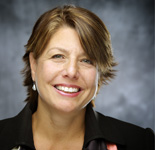Q&A with Jamie Moldafsky, Chief Marketing Officer, Wells Fargo & Company
Marketing and customer experience are two sides of the same coin: Marketers are responsible for communicating the brand promise, and customer experience professionals are responsible for making sure that the promise is kept.
It’s that synergy between marketing and CX that led us to invite Jamie Moldafsky, CMO at Wells Fargo, to speak at Forrester’s Forum for Customer Experience Professionals in New York on the morning of June 25. As a run-up to our event, Jamie took the time to answer a few questions about why Wells Fargo cares about customer experience and how its approach to CX has evolved over the years.
Enjoy!

Q: When did your company first begin focusing on customer experience? Why?
Treating customers with courtesy and respect has been a core value at Wells Fargo for more than 160 years. Back in 1888, its agents were given the following instructions: “Proper respect must be shown to all — let them be men, women, or children, rich or poor, white or black—it must not be forgotten that the Company is dependent on these same people for its business.”
Much has changed over the years, but the company has not lost it focus on its customers and helping them succeed financially. The latest expression of this commitment began in 2006 as the company embarked on its One Wells Fargo initiative, with its emphasis on improving customer experience by focusing explicitly on opportunities that cut across its 80-plus businesses and multiple distribution channels. The One Wells Fargo initiative provided enterprise-wide leadership, structure, and funding to seize opportunities and solve issues for customers engaging with the company across multiple business lines, including research and measurement, problem resolution, enhanced communications, and collaboration across business units.
We embarked on this recognizing the increasingly complex ways in which customers "experienced" us (our average household customer had five or six financial products with us, cutting across multiple business lines), and aware of the need to be more consistent and integrated in our customer experience approach. We believed that our customers saw us as one company, and we wanted to make sure they experienced us seamlessly as One Wells Fargo.
Q: What, if anything, is different about what you're doing now to improve customer experience versus what you did when you were starting out?
The world is even more complex and changing more rapidly than when we began One Wells Fargo seven years ago. Large scale demographic, technological, and social changes bring with them new challenges and customer expectations, with more channels of commerce, more opportunities for engagement and more customized products/ services per customer. As a result, we have increased our focus on creating a more integrated experience, both in the way we design our products and go to market with them. This requires us to enhance our business disciplines, data and measurement approaches, and technology infrastructures and strengthen our core values surrounding customer experience and delivering a differentiated personal brand experience.
Q: What advice would you give to a company trying to plan their own path to CX maturity?
Various customer experience tools and techniques can be important to consider, but nothing is more important that creating a shared customer experience vision, building that vision into your culture, and demonstrating your commitment to that vision throughout the enterprise. It needs to start with leadership but has to be owned across the organization and, on some level, by every team member. If you want to see how we do that, go to wellsfargo.com and read our company’s Vision and Values. You can find it under the “About Us” tab.
